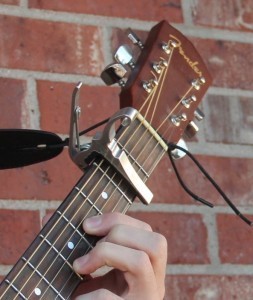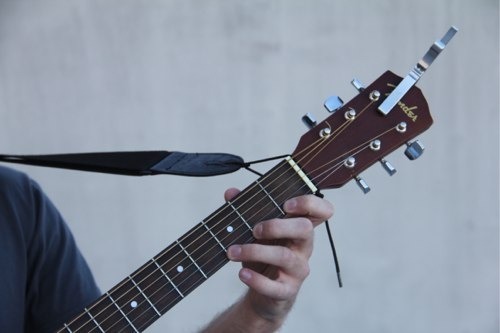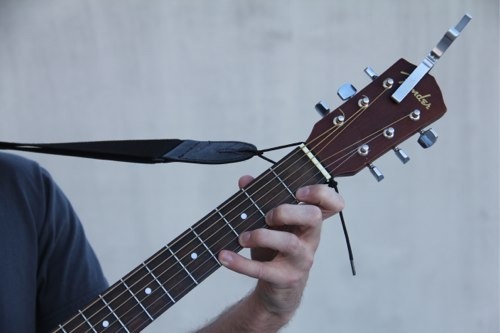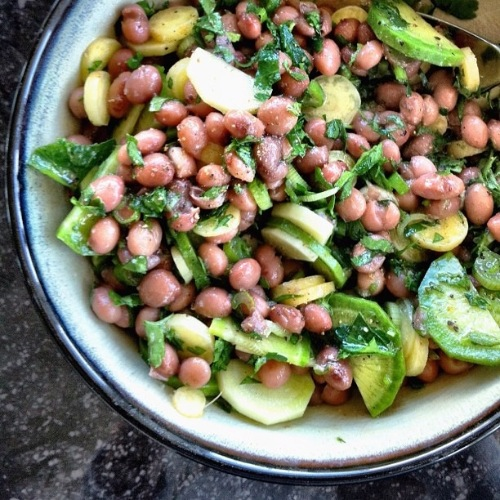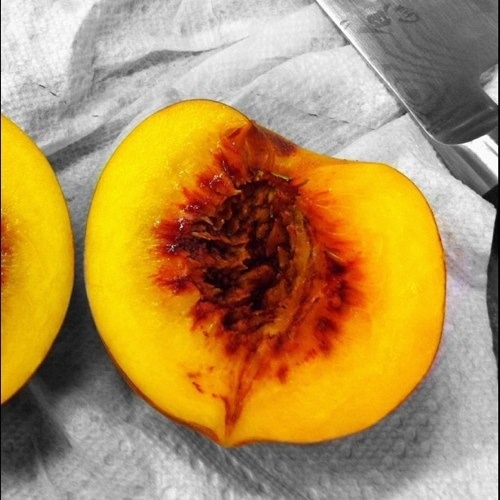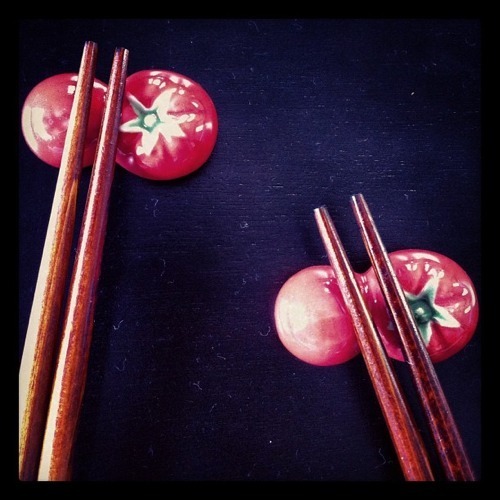Timothy Ferriss's Blog, page 113
December 20, 2012
11 X-mas Gifts That Can Change Your Life (Or Save Your Ass)

Smiling with the Hario hand grinder. Combine with the AeroPress below, and you can make world-class coffee on an airplane meal tray.
I dislike shopping, but I do love finding the perfect gift.
Finding that gift, though, gets harder with time. Those damn adults seem to already have everything. That includes me.
More salt and pepper shakers? Nah. Alternate versions of the shirts I got last year? No, thank you. In the eternal quest to eliminate clutter, I now give Santa a not-to-buy list instead of a wish list.
If you’re having trouble thinking up killer (in the good sense) gifts, here are 11 goods that deliver.
Prices are estimates, I advise two of them thanks to obsessions (#1 and #10), and all of them have either changed my life or saved my ass. OK, almost all. A few were thrown in purely for fun…
#1 – CLEAR Card – $49 for six months (35%+ off of normal $79)
I first used CLEAR card in 2007. It’s one of my secret weapons, and I never travel without it.
Hate the feeling of arriving at the airport and wondering if the security lines will take 5 minutes or 45 minutes…maybe longer? CLEAR allows you to skip security lines completely at enrolled airports (San Francisco, DFW, Denver, and more).
Now, I am never anxious going to airport. Uber takes 15 minutes from my door to check-in kiosk (eliminating parking), and I know CLEAR can get me through security in 5 minutes or less. Last time I timed myself during SFO rush hour, I was 25 minutes faster than the first-class line and more than an hour faster than the economy line… all with an economy ticket. Gift cards can be e-mailed or printed, and kids under 18 traveling with you go through the CLEAR lane for free.
#2 – Kershaw Ken Onion Leek Serrated Folding Knife with Speed Safe – $39
I have collected knives since taking pack trips through the Teton mountain range as a teenager.
This Kershaw knife with “open-assist” (basically a side-opening switchblade) is the most all-around convenient and useful knife I own. Fixed blade knives are awesome, and I own many, but the balance and utility of this Kershaw blade makes it my go-to default at home or on the road.
Be sure to get it with the serrated edge. Be sure not to leave it in your carry-on luggage. The TSA will make a frowny face otherwise.
#3 – Three Books, Three Eras
The Education of Cyrus (Cyropaedia) by Xenophon –
This was written a few years ago…in the 4th century BC. If you like Seneca or my other philosophical favorites, you’ll like this one. It was introduced to me by Wofford College president Ben Dunlap, one of the best teachers I’ve ever met in my life. For those interested, here’s his unreal Wikipedia entry. He embodies many of the lessons taught in The Education of Cyrus, as is clear in own his TED talk on lifelong learning and passion (the last 5 minutes are gold, if you need to skip around).
Levels of the Game by John McPhee –
John McPhee is probably my favorite non-fiction writer of all-time. He’s written about everything from oranges to hardwood canoes, and he transforms every subject into page-turning fascination. In Levels of the Game, published in 1979, McPhee writes his first book on tennis. I’m not a tennis player, but I loved this short, 149-page book. The critics got it right: “This may be the high point of American sports journalism.” (The New York Times) “McPhee has produced what is probably the best tennis book ever written.” (Life)
The 4-Hour Chef by Some Long Islander –
Writing The 4-Hour Chef changed how I look at learning, passion, and creativity forever. In 2007, if I’d had the contacts I do now, I would have written this book before The 4-Hour Workweek. Accelerated learning is the foundation for everything I enjoy, and it’s the force multiplier for everything in my previous two books.
Sidenote: Have you read The 4-Hour Chef already? If so, kind reader, could you please take 30 seconds and leave an Amazon review here? It’d mean the world to me. I’d love to hit 1,000 for a celebratory drink on 1/1! Also, if you’d like to explore the gear in the first 150 pages of the book, I’ve put it all here.
#4 – Amazon Prime + Roku + Escape to River Cottage – Around $152 ($79/year, $70, $1.99/episode)
I own an Apple TV, but I barely use it. Why?
Simple: An Amazon Prime membership gives me free 2-day shipping on almost everything Amazon.com, as well as 1,000s of free streaming movies and TV shows. To watch them on my TV, I just need the Roku box, which I also bought for my parents. It’s dead simple to use.
The most inspiring and life-affirming TV series I’ve watched using Prime/Roku combo is the British Channel 4′s Escape to River Cottage with Hugh Fearnley-Whittingstall. If you’ve ever fantasized about escaping the city to live in the country and live off the land, you will love this series.
#5 – AeroPress Coffee and Espresso Maker – $32
For this beauty, more than 300 reviewer said something like this: “I have a drip coffee machine, a french press and a Krups espresso maker, and they are all officially retired thanks to the Aeropress.”
If you combine it with a hand grinder and a non-stabby pocket thermometer, you can make the best coffee of your life on a plane flight…on the meal tray of a middle seat. I’m not kidding. Baristas often travel with an AeroPress for this reason exactly, and it takes less time to clean than a butter knife. Winning.
Extra trivia: The AeroPress was invented by the same rogue Stanford mechanical engineer who created the Aerobie toy craze.
#6 – BioTrust Low-Carb Protein Powder – $49.95
(Non-affiliate link)
I am always asked about protein powders, often related to my “30 within 30″ recommendation of consuming 30 grams (g) of protein within 30 minutes of waking up. My dad, as one example, went from 5 pounds of average monthly fat loss to 17.85 pounds/month in the first month of adopting this habit.
But what to use?
For the last several months, I’ve used BioTrust low-carb protein powder, and I plan to continue doing so. It contains just 4g net carbs per serving, mixes easily with a spoon, and I find the combination of undenatured whey protein isolate, micellar casein, and other proteins easy to digest but filling enough to act as a (small) meal replacement. This is an unusual combo, and I regularly keep six or so jars at home, and I travel with two jars. During book launch, I used the “30 within 30″ rule to sustain immune function while sleeping 2-3 hours per night at hotels around the country.
Be forewarned: I love the product, but like many companies, BioTrust has frequent e-mail follow-up for their related nutritional products. I’m allergic to e-mail and in elimination mode, so I opted out of this.
#7 – WaterPik Ultra Water Flosser – $45
I’ll keep this one short.
I have hated flossing my entire life. Each year, I got a lecture from the dentist, and each year, I’d attempt flossing for 2-3 days and throw in the towel. No longer.
Using the WaterPik in combination with the free Lift app got me to floss consistently for the first time. Now, I look forward to it. Weird.
#8 – Jumpcut – Free
This free download saved my sanity. It is my small gift for you.
As a writer, I cannot tell you how many times I’ve copied something important to the clipboard, gotten distracted, then copied something else…losing hours of work! Damnation! At the very least, such mistakes meant frustration and feeling like a sad keyboard monkey.
Meet Jumpcut.
Jumpcut appears on your toolbar and saves around 40 items you’ve copied to your clipboard. You won’t realize how time-saving (even life-changing) this is until you start using it. There are positive side-effects, too. Know all those temporary text files you use for notetaking for later in the day or whenever? Forgettaboutit — Jumpcut to the rescue. Special thanks to Maneesh Sethi for introducing me to this tool.
#9 – Splurge at The Billionaire Shop -$1,000,000+
Finally, a way for you to shop for your Danish Zenvo ST1 (limited to 15 in the world) online!
Ah, the conveniences of the Internet. No more shlepping down to your local Lamborghini dealership or waiting for helicopter catalogs. You can max out your AMEX black card here with one click, and that perfect X-mas gift will depreciate in 30 minutes more than the value of my current house. Enjoy!
#10 – Quarterly – My 4-Hour Obsession – $100/Quarter
Readers have been asking me for a box of physical goodies for years. So, my Lords and Ladies, I have created one with the start-up Quarterly.
Every three months — 4 times a year — you’ll get a box full of my favorite things, my newest and favorite obsessions. Through my global travels, my guinea pig self-experiments, my extensive product testing, and adventures/misadventures, I’ll find the coolest gems to share with you and pick the best for the box.
Tim Ferriss not your thing? A little too Ferrissy for ya’? Well, then… get off my lawn! But seriously, there are other cool folks to choose from, including Veronica Belmont, Mark Frauenfelder, Tina Roth Eisenberg (swissmiss), Jason Kottke, and Megan Collins. For gifting, you have the option of sending the gift confirmation directly (and immediately) to the recipient, or sending it to yourself so you can print or forward it as you see fit.
And Most Important of All…
#11 – What You Already Have – Priceless
The holiday season shouldn’t be all about stuff. It should be about connecting with others and reconnecting with yourself. Don’t get me wrong: I like toys and encourage you to play. Just don’t get so lost in the X-Box that you skip a proper year-in-review introspection.
Looking back on the year, looking ahead to the next, ask yourself:
- What and who am I grateful for?
- What and who should I be more grateful for?
Remember that if you don’t appreciate what you have now, nothing you get (e.g. house, jet, business, spouse, whatever) will make you happier, much less fulfilled. There’s more to life than increasing its speed and size. Drive both without focus and your life will end up resembling the Exxon Valdez: unwieldy and hard to control.
In the new year, what will you remove from your life? What will you learn and teach? What will you simplify?
Just as I recommend these questions, I’m asking them myself.
Happy holidays, all!
Wishing you and yours the most joyous of holiday seasons,
Tim






December 18, 2012
Hacking Kickstarter: How to Raise $100,000 in 10 Days (Includes Successful Templates, E-mails, etc.)
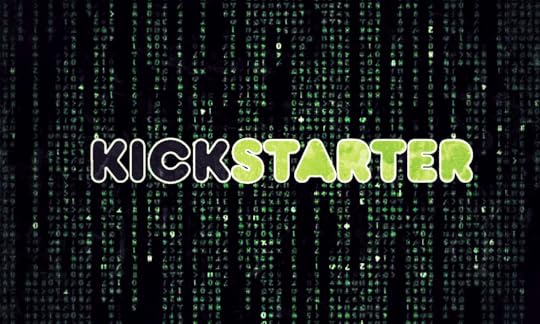
Mike Del Ponte co-founded Soma, which raised more than $100,000 on Kickstarter using virtual assistants and free apps.
I first met Mike Del Ponte two years ago when he was running marketing at BranchOut, a startup I advise.
Before joining BranchOut, Mike had explored a variety of career paths, including preparing for the priesthood at Yale Divinity School and serving as a peacemaker in the West Bank.
Earlier this year, Mike came to me with a new product idea called Soma. Soma is, in its simplest form, a high-end competitor to Brita water filters. It combines Apple-inspired design (e.g. sleek glass carafe) with a subscription service that delivers the world’s first compostable water filter to your door. From form to function, from funding model to revenue model, Mike was eager to disrupt a sleepy but enormous market: water. I became an advisor.
To launch Soma on Kickstarter (and raise $100,000+ in just nine days), Mike and his team used some of the techniques that helped BranchOut grow to 25 million users in just 16 months.
You can replicate what he did.
This post includes all of their email templates, spreadsheets, open-source code to build landing pages, and even a custom dashboard Soma’s co-founder/hacker Zach Allia built to monitor their Kickstarter data, social media, and press.
This post is as close to copy-and-paste Kickstarter success as you will find. And even if you have no interest in Kickstarter, Mike’s approach is a blueprint for launching nearly any product online for maximal impact and minimal cost.
Enjoy!
UPDATE: Soma is offering a 7-course, private dinner with me at a historic mansion in San Francisco (travel included) as one of their Kickstarter prizes. At the time this post was published, there was still one spot left.
Enter Mike
How many times have you dreamt of launching a new product, only to let your dream fall to the wayside?
I don’t have the money to even get started! What if it fails?
In the past, these excuses held some weight, as bringing a new product to market could be incredibly expensive. Oftentimes, you had to prototype, build, and then hope the world wanted what you were selling. If not, you could end up with a warehouse full of debt: unsellable inventory.
Now, there are new options. Crowdfunding platforms like Kickstarter and IndieGogo allow you to introduce (test) a new product before you start manufacturing, removing a huge amount of risk. If people like what you’re proposing, you can pull in thousands or even millions of dollars to fund your dream. At the very worst, you were able to test your idea without investing much time or money.
But planning and running a Kickstarter campaign is often done in a haphazard fashion.
To prepare for ours, we didn’t want to leave anything to chance, so we interviewed 15 of the top-earning Kickstarter creators. Their projects ranged from a grizzly bear jacket to a gaming console that raised nearly $8.6 million on Kickstarter. What we learned is that whether you’re successful or struggling, your Kickstarter campaign is often “40 days of chaos,” as one creator put it. Either you succeed beyond your wildest dreams and are overwhelmed with inquiries from backers, press, retailers and investors, or you struggle to achieve your goal and frantically beg bloggers and friends to spread the word. Either type of overwhelm can be a huge headache.
So, we got creative.
Using virtual assistants, growth hacking techniques, and principles from Tim’s books, we raised over $100,000 in less than 10 days. Having accomplished our goal with almost 30 days to spare, we are now relaxing for the holidays. The Kickstarter is behind us, allowing us to get back to product development as we get to know our new community of 1,600+ committed customers.
Here are the steps we used to do it…
Step 1: Start with principles that require less work and yield better results
We chose three core principles for our Kickstarter strategy. The hacks and tactics we’ll share with you are cool, but these principles were the foundation of our campaign. Make sure you understand them before moving forward.
Minimum Effective Dose. MED is the smallest input needed to produce a desired outcome. For example, if you want to boil water, the MED is 212 degrees Fahrenheit. Increasing the temperature above 212 degrees will not produce a better result, it will just waste resources. We wanted to focus on the 1-3 things that would allow us to raise $100,000 in 10 days, and eliminate everything else. MED is described in detail in The 4-Hour Body .
Outsource and automate. These two steps allow you to get results by delegating tasks and setting up automated systems so you can focus your energy on more valuable projects. The #1 resource we found for outsourcing is Zirtual. Zirtual provides US-based virtual assistants (VAs) for as little as $97 a month. Do not run a Kickstarter campaign (or your life) without VAs. They will save you countless hours of work. The 4-Hour Workweek is the best book on outsourcing and automating.
Prep and pick up. Chef’s don’t prepare meals like you and me. They don’t start 15-60 minutes before dinner. Instead, they prep everything in advance (sometimes days before), so they can just heat the food and make it look nice when it’s time to eat. This concept was critical to our success. Our goal was to do 90% of the work in advance. For example, crafting emails 2-3 days early so we just needed to click “send” when we launched. We learned about prep and pick up in The 4-Hour Chef . It’s a game changer.
Step 2: Find the MED for Kickstarter traffic
If you want to raise a lot of money on Kickstarter, you need to drive a lot of traffic to your project. And you want that traffic to be comprised of prospective backers of your project. Applying the concept of MED, we knew we needed to discover and focus on the best traffic sources.
My friend, Clay Hebert, is a Kickstarter expert. One of the things he taught me is a simple trick using Bit.ly tracking. Bit.ly is a link shortening service used by millions of people…and Kickstarter. If you add a + to the end of any bit.ly URL, you can see stats about that link. For example: here are stats for the shortlink Kickstarter generated for our campaign http://kck.st/VjAFva+.
Click here for full size image
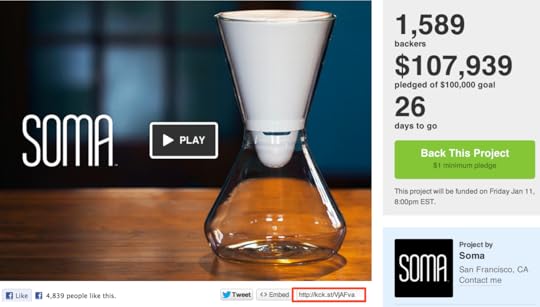
Click here for full size image
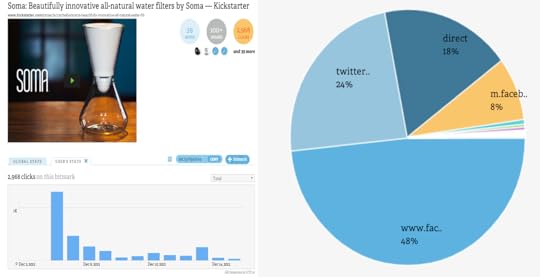
To discover the top referral sources, we gave our VA a list of Kickstarter projects similar to ours and asked her to list the referrers for each project. Almost without fail, the order of top referrers was:
Direct traffic (primarily via email)
Kickstarter
Blogs
Based on this data, we decided to focus all of our attention on just two goals:
Getting coverage on the right blogs
Activating our networks to create buzz on Facebook, Twitter, and email
We knew that if we did this, we would be listed on Kickstarter’s “popular projects” sections, which is how you get people who are browsing Kickstarter to check out and back your project.
Step 3: Use the 80/20 rule to focus on the best media targets
At Soma, we were fortunate to get a ton of press in just 10 days (Forbes, Fast Company, Inc., Mashable, Cool Hunting, Business Insider, GOOD, Salon, Gear Patrol, Thrillist, The Huffington Post, and many more). We made mistakes and learned a lot. This section offers our best advice on how to get the MED of press and succeed on Kickstarter.
The 80/20 rule teaches us that 20% of stories will yield 80% of your press results. This was absolutely the case for us. One week into our Kickstarter campaign, we reviewed our press coverage. Surprisingly, the post that earned us the most money was on a site most people have never heard of: www.good.is, the online property of GOOD magazine.
We stopped and asked ourselves, “Why did good.is outperform bigger and more well-known media outlets?” We discovered that good.is was in some cases 10x more valuable than other press because the audience is relevant, the readership is substantial (400,000+ unique monthly visitors), we got an introduction to a writer at GOOD, and we reached prospective backers through GOOD’s daily email and its Facebook and Twitter accounts.
Therefore, when making your media list, these are the four things to look for:
Relevance – will their readers LOVE your project?
Readership – how much traffic does their site get? [TIM: For a quick idea, I use the SEO for Chrome extension]
Relationships – do you know at least one person who can make a strong introduction?
Reach – will the blog reach prospective backers by promoting your post via email newsletter, RSS feed, Facebook, Twitter, and other channels? [TIM: This is the most neglected checkbox. Blogs that expect you to drive all traffic to their posts are a waste of time. Remember: big site-wide traffic does not mean each post gets much (or any) traffic.]
What follows is a 5-step process for making the world’s greatest media list. Your VA will do 90% of the work. We’ve included email templates you can use to delegate these projects to your VA.
I. Find relevant bloggers using Google Images
Start by looking at who covered Kickstarter projects similar to yours. You can do this by using a simple Google Images hack. If you drag and drop any image file into the search bar at images.google.com, you’ll be shown every website that has ever posted that image. Pretty cool, huh?
Click here for full size image. Below, the Porthole by Martin Kastner.
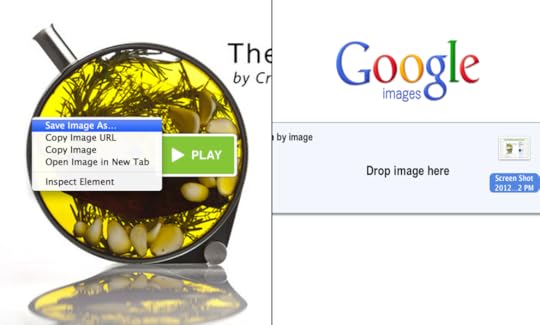
Here’s the process your VA will use:
Find 10 Kickstarter projects similar to yours, and for each, do the following.
Right-click and save-to-desktop 2-3 images.
Drag and drop each image file from your desktop into the Google Images search bar.
Review blogs listed on the results page to see which might be relevant to your project.
Fill out the following fields in the attached “Media List” spreadsheet: Publication, URL, first and last name of the writer, and links to relevant posts by that writer.
You now have dozens of blogs that have a high probability of relevance, all neatly organized in a spreadsheet. Your VA can find more sites like the ones in your media list by searching SimilarSites.com.
II. Research site traffic on Compete.com
Bigger is not always better. But it is helpful to know the size of each blog’s readership. Have your VA research how many unique monthly visitors each blog has and add that data to your media list.
III. Identify relationships on Facebook
This may be the most important part of your PR efforts. For us, eight out of ten valuable blog posts resulted from relationships. Either we knew the blogger or got an introduction. When we pitched a blogger without a relationship, less than 1% even responded. With introductions, our success rate was over 50%.
How do you identify relationships? Facebook. Have your VA log in to your Facebook account, search for bloggers in your media list, and add mutual friends to your spreadsheet. You can also search on professional networks like BranchOut or LinkedIn.
IV. Discover each blog’s reach on email, social media, and RSS
After witnessing the value of good.is featuring Soma in their email newletter, we completely changed the way we thought about press coverage. A blog post is just the beginning. Once you get covered, you need distribution. You need to reach your prospective backers through email, RSS feeds, and social media.
To estimate a blog’s reach, have your VA research how many followers it has on Facebook, Twitter, Pinterest, and RSS. Once you make your short list of media targets (see below), you should also sign up for each blog’s email newsletter.
You won’t really know what your reach will be until you’ve landed each story and received a commitment by each blog to promote your posts. But don’t worry, we’ll help you get both below. So keep reading.
V. Review your media list and turn it into a dossier fit for a Seal Team 6 secret mission
Ok. So now you have a really strong media list…and all you had to do is send four emails, which we wrote for you. Not bad. Now it’s time for you to double check your VA’s work and create your blogger shortlist.
Open your media list spreadsheet and look at the mutual friends you share with each blogger. Delete the people you do not know well enough to ask for an introduction. Email the people who remain and say, “Hey ____, I saw you’re friends with [name of blogger] on Facebook. Do you know him well enough to make an intro next month? I think our Kickstarter project could be a good fit for [name of blog]. Thanks!” Based on the answers you get, rate how strong your relationship is for each blog (1 = strong, 3 = weak). If your VA didn’t find any mutual connections, tweet or post on Facebook: “Please message me if you know anyone at [name of blog]. I have a great story I’d like to share with them. Thanks!” I did this twice and immediately got introductions.
Spend some time on each blog and judge for yourself how relevant it is. Rate relevance in the spreadsheet (1 = extremely relevant, 3 = not relevant).
For each blog, research the writers your VA found. Based on their past posts, are they really the best bloggers to cover you? Is there anyone at the blog who is a better fit?
Now, sort your spreadsheet by relevance, relationships, and readership (in that order) to prioritize your outreach. Have your VA find email addresses for the top ten bloggers in your spreadsheet. At this point, you should only focus on ten bloggers.
Using this template, have your VA make a one-page brief for each of the top 10 bloggers. Print these out and hang them on the wall like wanted posters or put them in a top secret dossier. Whether you fancy yourself a bounty hunter or the next James Bond, your mission is to find, befriend, and get covered by these bloggers so the dream you’re launching on Kickstarter can become a reality.
Step 4: Turn bloggers into buddies
The only thing better than pitching a blogger through a friendly introduction is becoming friends with the blogger yourself.
If there’s one thing we learned from our Kickstarter campaign, it’s that friends are incredibly generous. They will go to great lengths to help you succeed. Blogger friends are no exception. Some of our blog posts came from close friends who offered to help before we even asked. For example, this Fast Company article by Amber Rae that got over 6,000 Facebook likes and 4,000 tweets in just 10 days.
The key is to genuinely form friendships with bloggers. They get pitched every day by strangers who don’t care about them and only want publicity. Do the exact opposite. Really care about them. Figure out ways to be helpful. Hang out. Even if they don’t end up covering you, at least you’ll have a new friend.
Step 5: Get the story and make specific requests to maximize your reach
Once you connect with a blogger that is interested in covering your project, your job is to make it as easy as possible for them to write a story that is valuable to their readers and to you. The benefit of starting with a shortlist of just 10 bloggers is that you can really get to know their blog and writing style. Armed with this information, you can tailor your pitch to their needs. For example, after receiving an email introduction to a blogger at Gear Patrol, the ultra cool men’s digital magazine, I sent over this pitch (to someone not named John):
Hi John
It’s great to meet you. I’m a huge fan of Gear Patrol and wanted to pass on something new that could be a nice fit for your kitchen section. I’ve attached an image of the Soma glass carafe and our revolutionary water filter. Our Kickstarter page has a video and bullet points on why Soma is unique.
We think Soma could be a great story for Gear Patrol for these reasons:
Innovative gear – Soma is the world’s first compostable water filter: made of Malaysian coconut shells, vegan silk, and food-based plastic.
Sleek design – The Soma carafe is made of decanter-quality glass, in a world of plastic pitchers. The hour-glass shape is unprecedented in the industry.
Made for busy guys – Soma delivers your water filters right to your door so you never forget when to change it.
If you’re interested, please let me know how I can make the writing process easy for your team. I’m happy to send more hi-res photos. We launch Tuesday at 8am PST.
Thanks for taking the time to check us out,
Mike
The good thing about Kickstarter is that most of the information and assets bloggers need for a story can be found right on your Kickstarter page, including high resolution photos and the embed code for your video. We built a press page and wrote a press release. In retrospect, they may not have been worth it given the amount of time we spent on them. All you need is a DropBox folder with hi-res photos and 5-7 bullet points about your project that you can paste in an email. The key is to make sure you package everything in a way that’s convenient for bloggers.
[TIM: For more real-world successful pitches (e.g. Wired Magazine, Dr. Oz), see my post "From First TV to Dr. Oz – How to Get Local Media...Then National Media"]
Once you get the story, your work is far from over. Remember, you want to ensure each story reaches people who will back your project. So after a story is confirmed, make sure to ask the blogger the following questions, ideally in person or over the phone one week prior to launch.
“We’re launching on Monday at 8am PST, can the story go live at that time?” If they say “no,” ask for the story to be published at another time on Monday, Tuesday or Wednesday 8am-5pm PST, ideally in the morning. If they say, “I’ll try,” push for a confirmation of the date and time your story will go live. We missed out on a lot of valuable traffic because big blogs posted our story at night or on the weekend.
“As a subscriber to your email newsletter, I always read the stories you curate and am sure others do, too. Can our story be featured in your newsletter?”
“We’ve found that Facebook is the #1 source of traffic to Kickstarter. Can you post our story on your Facebook fan page the morning it goes live? Cool! And I’m assuming you’ll tweet it out, too, right? Awesome!”
“I follow you on Pinterest and noticed you have like a gazillion followers. We pinned a new picture of our product. If I send you a link, would you mind repinning it?”
Once we realized how important timing and promotion were, we started making these requests. To be honest, initially I was nervous. I thought it would be more polite to not bother bloggers. But then I learned two important lessons. First, bloggers work hard to create content and they want it to be seen by as many people as possible. And second, bloggers won’t get annoyed by your requests if you’re polite, explain why timing and promotion are so important, and give them the time and help they need to work within the confines of a content calendar they may not control. The more you befriend bloggers and consider their fears and motivations, as well as your own, the better your results will be.
What I’ve just shared with you is a step-by-step approach to getting the most effective media coverage possible. I’ve worked with PR firms that charge $20,000 a month and spend three-months planning a launch. Follow our advice and there’s a good chance you’ll get better results without spending anything.
What I’m about to share, how to activate your network, is equally as important. In both cases you want to create what Tim calls “the surround sound effect.” Especially on the first few days of your launch, you want people to see your project everywhere – on blogs, Facebook, Twitter…everywhere. One tool that creates this surround sound effect is retargeting. For as little as $500, you can display banner ads on various sites to 10,000 people who have seen your project, but may not have backed it. I haven’t heard of many Kickstarter projects using retargeting, but it’s something worth investigating.
Step 6: Segment and activate your network
Someone recently asked us, “How did Soma raise $100,000 on Kickstarter in just nine days?” Our answer: friends. The secret to our success was leveraging our personal networks. Our friends introduced us to bloggers, were the first to back our project, and promoted Soma to their personal networks via email, social media, and word of mouth. Your friends are super heroes. Treat them as such.
The way to activate your network of friends is to give them a sense of ownership. Let them know they are part of the team. That way, they are working with you, rather than doing you favors.
Our Kickstarter launch team included three full-time teammates, two virtual assistants, one intern, and an army of friends. Our network of friends had a strong sense of ownership because we engaged them months before the Kickstarter launched. Here’s how.
Ask for (and listen to) your friends’ advice. We asked for feedback on everything from our name to product design to pricing.
Offer them “sneak peaks” that no one else gets. We showed our friends product renderings, pictures, and our Kickstarter video long before we released them to the public.
Throw a launch party. Having a large group of people in one room, all excited about your project, creates a united energy you can’t create through emails, phone calls, or one-on-one meetings. Invite over 50 motivated and influential friends, show them your Kickstarter video and make a speech telling them why you need their help and exactly what you need them to do. The people who attended our launch party ended up being our first backers and our most passionate evangelists.
Segmenting friends to ensure appropriate messaging
I went through the tedious process of making segmented email lists for my personal network. Since this involved making decisions based on my personal relationships, it was impossible to outsource. It was annoying, but worth it. I exported all of my Gmail contacts, about 7,200 total, into an Excel spreadsheet. Then, I deleted 6,000 contacts I did not have a meaningful relationship with. The remaining 1,200 contacts were divided into three groups: influencers, in-the-know friends, and acquaintances.
I identified my influencers using Klout, which measures online influence. Go to www.klout.com, connect with Facebook, select “friends” from the drop down menu in the upper right hand corner of the screen, then click on the “top klout score” tab half-way down the page on the right. This will show all of your Facebook friends, ranked by Klout score. Anyone with a Klout above 60 was put on my influencer list. Our goal for this group was for everyone to share Soma on Facebook and Twitter, right when we launched, to create the surround sound effect.
My in-the-know friends were already aware of Soma. They knew about the Kickstarter campaign, and that we wanted them to back our project and spread the word. The people in this group, regardless of their Klout score or financial resources, were ready to hustle for us.
Acquaintances were people I hadn’t spoken with in a while. They needed to be told what Soma is and why it’s important. This group was by far the largest, comprising at least 1,000 of the 1,200 people on my master list.
Each of these three groups received a different email when we launched, which you can see here. The acquaintances received a mass email sent via MailChimp. The influencers and in-the-know friends each received a personalized email, everyone was slightly different.
Personalized emails require much more time than one mass email, but we put in the extra hours to honor our friends and reinforce that they’re part of the team. One tool proved to be a huge time saver. TextExpander allows you to paste any saved message – whether it’s a phone number or a 2-page email – into any document or text field, simply by typing an abbreviation. For example, when I type “ppush”, a basic form of the email above appears with fields for me to fill in the name, in this case “Joe”. It’s a must have app that probably saved us 1-2 hours a day in typing.
One tool that we did not use, but should have, is Boomerang, a Gmail plug-in that allows you to schedule emails. We crafted emails to our influencers and in-the-know friends the day of our launch, using TextExpander, then slightly customized each one. What we should have done is write and save these personalized emails a few days before we launched. That way, we could have scheduled them to be automatically sent by Boomerang the second we launched. This would have freed up many valuable hours on launch day.
Step 7: Use landing pages to spark sharing
You’ll notice in our email templates that we often send people to landing pages we built for our Kickstarter launch (rather than to our Kickstarter page directly). We realized that most Kickstarter creators do one of two things:
They ask for too many things (“Back us! Tweet! Like us on Facebook! Email friends!), which often results in people doing nothing at all.
They ask for just one thing, which people do, but miss out on other actions their friends might do if asked the right way.
We wanted to have our cake and eat it, too. So we asked our friends to click just one link, which of course, had 3 ways to help! Then, when they returned to their email, we had a subsequent ask, which was to forward the email to others.
Why it worked: Essentially we were asking them to do just one thing at a time, typically just to click something.
Throughout the campaign we built two more landing pages. Each were meant to maximize sharing on social media, primarily Facebook. We included videos so our friends were incentivized to visit the landing page and got value. These videos were recorded on an iPhone. They were free to make and only took about an hour to shoot, edit, and upload. Highly recommended.

The emails and landing pages were sent out on days 1, 2 and 9, usually at 8am. We’ve left them up so you can check them out: Day 1, Day 2, Day 9. You can see the emails and Kickstarter updates here.
These landing pages were critical when it came to creating the surround sound effect. We know because every time we launched one, we got flooded with texts and emails saying, “Dude! I’m seeing you guys everywhere. Congrats!” When you get a lot of people sharing the same link on Facebook, it’s displayed to more people, who share it with even more people, and you get this virtuous viral burst that keeps growing.
You can make your own custom landing pages by using our opensource code.
Final thoughts
If you look at our advice, it essentially boils down to empowering people and making it easy for them to contribute to a worthy cause. Always try to empathize with other people. And take the time to say, “Thank you.” It goes a long way.
The best story we heard about using Kickstarter to derisk a business was by the founders of Hidden Radio, which raised $938,000 on Kickstarter. Inspired by The 4-Hour Workweek, they wanted to test out ideas as much as possible. So before building a prototype, they submitted product renderings to a few design blogs. The response was positive, but they didn’t rush into manufacturing. Instead, they tested their idea again as a Kickstarter project, knowing it forces people to put their money where their mouth is. 5,300 people backed their project, which provided proof of concept, capital, and a big group of customers willing to provide free market research. To us, this is a great example of hacking Kickstarter. It’s about a mindset, not just tricks and technology.
Although we stopped marketing our Kickstarter on day 9 of the campaigin, our page is still up and you can reserve a Soma until January 11, 2013. If you’re fast, you may also get a private, 7-course dinner with Tim Ferriss, which is the last reward listed on our Kickstarter page.
Tools
Zirtual – US-based virtual assistants. ($97-$997 per month)
TextExpander – Paste frequently used text and pictures into documents, emails, and text fields by simply typing an abbreviation. ($34.95)
Boomerang – A Gmail plug in that allows you to schedule emails. You can also receive reminders to follow up on an email you sent if the other person does not reply. (Free)
MailChimp – A service to design and send mass emails. (Free if you have less than 2,000 subscribers and send less than 12,000 emails per month)
The 22 Immutable Laws of Marketing – This book provides critical insights on how best to position your product amongst the competition. ($11)
Brainfluence: 100 Ways to Persuade and Convince Consumers with Neuromarketing – A must read for anyone doing any form of marketing. The sections on pricing and copywriting will be incredibly helpful as you craft your emails, video script, and Kickstarter page. ($17)
Custom Kickstarter dashboard – We built this Chrome extension to manage our Kickstarter campaign. You can see your Kickstarter, Facebook and bit.ly metrics, as well as tweets and press. All updated in real time. You can even see Klout scores of people tweeting about you and reply right from the dashboard. (Free)
Click here for full size image
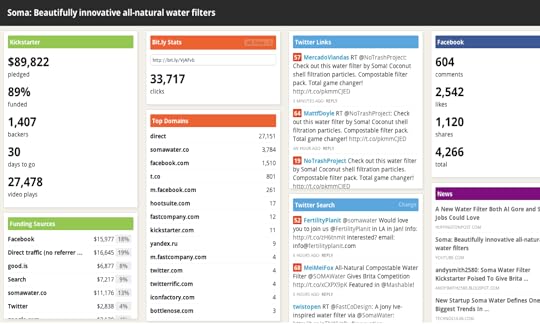






December 11, 2012
How to Finally Play the Guitar: 80/20 Guitar and Minimalist Music

When will you stop dreaming and start playing? (Photo: Musician “Lights”, Credit: Shandi-lee)
I’ve always wanted to play the guitar.
It started as a kid, listening to my dad play around the fireplace during the holidays. The fantasy continued with Guns N’ Roses and the iconic Slash. From hyperspeed Slayer to classical Segovia, I was mesmerized.
But I never thought I could do it myself.
Despite tackling skills as esoteric as Japanese horseback archery, I somehow put music in a separate “does not apply” category until two years ago. It was simply too frustrating, too overwhelming.
My fascination with guitar wasn’t rekindled until Charlie Hoehn, an employee of mine at the time, showed me the 80/20 approach to learning it.
This post explains how to get the most guitar mileage and versatility in the least time…
Do you have any additional tips, whether for guitar or applying the 80/20 principle to another instrument? Piano, violin, flute, or other? Please share in the comments!
Enter Charlie
Almost everyone has fantasized about performing music in front of a huge screaming crowd at some point in their life. For me, I’d always dreamed of playing guitar with the same mastery as Jimmy Page, Allen Collins, or Mark Knopfler. Sadly, I could never stick with guitar practice. I ended up quitting multiple times for a host of reasons: the material was boring, my teacher moved too fast, my teacher moved too slowly, my fingers were killing me, my wrists were sore, I wasn’t making enough progress, and so on.
Then my friend Jake Ruff taught me two simple exercises that changed everything, and I’ve been able to stick with guitar ever since.
Some guitarists proclaim that you need to tackle music theory first, while others will tell you to learn sheet music while you’re practicing chords. I found it most effective to focus on a few easy exercises, while minimizing boredom and pain. In other words, the process for learning that you enjoy the most is the best one, even if it isn’t comprehensive.
Comprehensive comes later. First, we need to get you hooked.
The Ground Rules
In order to get past the initial pain period that comes with learning guitar, it’s critical to manage your expectations. If you don’t have a clear understanding of what these first few weeks will be like, there’s a good chance that you will get frustrated and give up.
Here are the three things you need to know before learning guitar, under my plan or anyone else’s:
1. You will feel clumsy. Remember when you first learned how to type? You wanted to hammer out 100 words per minute, without ever making an error. The reality? You constantly had to look down at the keyboard, and you’d get frustrated whenever you made a mistake. Guitar is the same way. As much as you’ll desire the ability to play all your favorite songs beautifully, your body and brain simply won’t be able to. Your fingers will move slowly, your hands will feel awkward, and the sounds coming from the guitar will not be easy on the ears. Relax, and give yourself permission to suck. Allow yourself several weeks to build “muscle memory” – getting comfortable having your hands in positions they aren’t used to.
2. Your fingers will be sore. Expect the tips of your fingers to hurt for at least a month while they’re developing calluses. If your fingers get extremely sore, take a day off, and never play until your fingers bleed.
The pain you’ll feel is largely unavoidable, but you can reduce it by using a capo (a clamp you fasten across the strings of the guitar – read more on this in “Getting Started” below). The most important thing, of course, is to not quit playing altogether because of the pain. Whenever you want to quit because it hurts your fingers too much, say to yourself, “Justin Bieber taught himself to play guitar before he was 12.” Yes, that’s right. That effeminate kid successfully got through the same pain you’re feeling, and so has every other guitar player on the planet. You’re more than capable of pushing through.
3. You need to practice for at least 10 minutes each day. There is no quick path to mastering the guitar, but there is a fast track to failing: a lack of practice. During the first month, you need to make playing your guitar for at least ten minutes into a daily habit. Playing every day will help you build calluses faster, and increase your comfort level with the instrument.
When I first started, I aimed for at least two 10-minute practice sessions each day. I found the most convenient time to practice was while watching TV. The two exercises you’ll be focusing on won’t require intensive periods of concentration, so it’s totally fine to watch your favorite show while strumming away.
Getting Started
First and foremost, you’ll need to buy a guitar (See guitar recommendations below in the Gear section). I know it’s obviously possible to learn with a friend’s guitar or one that’s been given to you as a gift. However, I found that my desire to learn increased substantially only after I put some skin in the game. Buying my first guitar only cost me $100, but spending that amount made me much more committed to learning.
I strongly recommend starting with an acoustic guitar, rather than an electric. With an acoustic, you don’t have to plug it in to play and there’s less of an upfront investment (i.e. you don’t need to buy an amp). Learn on an acoustic first; if you decide to play electric later, the transition will feel much easier than it would have had you only learned to play electric.
Next, you’ll want to buy a capo. This is a clamp that raises the pitch of the strings. You’ll be using it for a different purpose, but to start, it will help reduce the pain in your fingers.
The capo pushes down on the strings, putting them closer to the fret board and thereby making it easier for you to push them all the way down with your fingers. When you’re doing the exercises, I suggest putting the capo on the second fret.
You don’t have to use a capo, of course, but it can really help while you’re still developing calluses.
Once you have your acoustic guitar, capo, and a few other essentials (see the Gear section at the end of this chapter), you’ll need to put the strings on and get them in tune. Here are a couple videos that will help you do both of these things:
Changing acoustic guitar strings tutorial
For tuning, the $3.99 ClearTune app works really well and is convenient to keep on hand when playing, particularly in the beginning. It’s available for both iPhone and Android.
Now that you’re all set up, it’s time to take a seat in a comfortable chair and get in position to play.
The most important thing about your posture is to stay relaxed. Because you’ll be pressing down hard on the strings, you’ll often feel your upper body tense up. Take a deep breath and only maintain pressure in your fingers.
One final note on your positioning: Your thumb should not wrap around the neck of the guitar; it should be pressed against the back of the neck. Sure, you’ll see a lot of professional guitar players who don’t comply with this, but it’s much easier on your hand to learn chords this way.
Without further ado, let’s get started!
Exercise 1: G-C-D
The number of chord variations you can learn on guitar is seemingly endless. We’re going to start with three of the basics: G, C, and D.
Before we get into explanation of this exercise, take a look at how to hold the G, C, and D chords: [Note the use of the silver capo in the photos]
The “G” Chord
Index finger on the fifth string, second fret.
Middle finger on the sixth string, third fret.
Ring finger on the second string, third fret.
Pinky finger on the first string, third fret.
The “C” Chord?1
Notice that, from G, fingers 1 and 2 are each dropping down one string. Otherwise, the hands are the same. So, for C:
Index finger on the fourth string, second fret.
Middle finger on the fifth string, third fret.
Ring finger on the second string, third fret.
Pinky finger on the first string, third fret.
The “D” Chord
Index finger on the third string, second fret.
Middle finger on the first string, second fret.
Ring finger on the second string, third fret.
Pinky finger stays off the fret board.
In the G-C-D exercise, you’ll be working on switching from chord to chord. Here’s all you need to do:
Form the G-chord. Strum.
Transition to C-chord. Strum.
Transition to D-chord. Strum.
Transition to C-chord. Strum.
Repeat steps 1-4.
Each time you switch to a new chord, you should first pluck all six strings individually to ensure that six crisp, clear tones ring out. If any of the strings sound muted or dull when you pick them, check your fingers to ensure that (A) you’re holding the strings all the way down on the fret board, and (B) each finger is only touching/holding down one string.
Once all six strings sound nice and clear individually, you can begin strumming to hear the full sound of the chord. Strum lightly for 10-15 seconds, making sure that the chord sounds nice and clear with each strum, then transition to the next chord.
After you’ve reached a point where you’re fairly comfortable with transitioning between these three chords, you’ll want to try playing along with actual music. Jamming to your favorite songs is definitely the most fun way to learn in the beginning, because it really feels like you’re producing a better sound than you actually are. It also forces you to get better at matching the correct tempo of a song while strumming.
Here are several popular songs that are great for practicing the G-C-D exercise:
Lynyrd Skynyrd – Sweet Home Alabama (YouTube, Guitar Tab)
Green Day – Good Riddance (YouTube, Guitar Tab)
Sublime – What I Got (YouTube, Guitar Tab)
AC/DC – You Shook Me All Night Long (YouTube, Guitar Tab)
Van Morrison - Brown Eyed Girl (YouTube, Guitar Tab)
Steppenwolf – Magic Carpet Ride (YouTube, Guitar Tab)
Violent Femmes - Blister (YouTube, Guitar Tab)
Really listen to each song. Try to distinguish the difference in tone between the G, C, and D chords, and see if you can match what you’re hearing. If you have trouble, find the the song on www.ultimate-guitar.com to see (1) what chords you’re hearing, and (2) when to make transitions between these chords.
The songs are all heavy on G-C-D. Some are comprised entirely of those three chords. Here’s the breakdown:
“Sweet Home Alabama” by Lynyrd Skynyrd
D-C-G
“Good Riddance” by Green Day
G-C-D
“What I Got” by Sublime
D-G
“You Shook Me All Night Long” by AC/DC
G-C-D
“Brown Eyed Girl” by Van Morrison
G-C-D-Em
“Magic Carpet Ride” by Steppenwolf
D-C-G-Bb-Gm
“Blister” by Violent Femmes
G-C-Em-D
Exercise 2: The Fret Climb
The purpose of the second exercise is to get you comfortable with moving your fingers up and down on the fret board. The below images will give you an idea of what the Fret Climb looks like. You can use a pick for this exercise, or just use your fingers to pluck the strings.
Here are the exact steps for this exercise:
Push down on the first string (the one furthest from you), 1st fret, with your index finger. With your other hand, use your index finger to pluck the string. Ensure that a clear, crisp tone emits. If it sounds dull or muted, press down harder on the string.
Push down on the first string, 2nd fret, with your middle finger. With your other hand, use your middle finger to pluck the string.
Push down on the first string, 3rd fret, with your ring finger. With your other hand, pluck the string with your index finger.
Push down on the first string, 4th fret, with your pinky finger. With your other hand, pluck the string with your middle finger.
Move your index finger down to the fifth fret.
Push down on the first string, 5th fret, with your index finger. With your other hand, pluck the string with your index finger.
Continue “climbing” the fret board until you’ve reached the 12th fret.
Once you’ve climbed all the way up to the 12th fret, it’s time to do the exercise in reverse. Go all the way back down the string, moving up the neck of the guitar one fret at a time, and plucking the string each time your fingers move down a fret.
After you’ve gone up and down the first string, switch to the second string. Do this exercise on all six strings.
Again, it’s important to ensure that you’re getting nice, crisp tones each time you pluck the string. Don’t rush through the exercise if the tones aren’t perfectly clear.
Once you’re comfortable with the Fret Climb, try to increase your speed.
Next Steps
Once you’ve mastered the G-C-D and Fret Climb exercises, you’ll have a nice solid foundation that you can build upon in the months to come. But what do you do after you’ve perfected those two exercises?
I suggest mimicking the Axis of Awesome, then picking and choosing your favorites to learn.
Axis of Awesome
First, prepare to have your mind blown. Then, watch the The Four Chord Song by Axis of Awesome.
This comedy trio plays 38 pop songs in five minutes using just the E, B, C#m and A chords. Pick up those new chords, use www.ultimate-guitar.com to look up the below songs for ordering, and you can play them.
How’s that for Minimum Effective Dose?
1. Journey – Don’t Stop Believing (YouTube, Guitar Tab)
2. James Blunt – You’re Beautiful (YouTube, Guitar Tab)
3. Alphaville – Forever Young (YouTube, Guitar Tab)
4. Jason Mraz – I’m Yours (YouTube, Guitar Tab)
5. Mika – Happy Ending (YouTube, Guitar Tab)
6. Alex Lloyd – Amazing (YouTube, Guitar Tab)
7. The Calling – Wherever You WIll Go (YouTube, Guitar Tab)
8. Elton John – Can You Feel The Love Tonight (YouTube, Guitar Tab)
9. Maroon 5 – She Will Be Loved (YouTube, Guitar Tab)
10. The Last Goodnight – Pictures Of You (YouTube, Guitar Tab)
11. U2 – With Or Without You (YouTube, Guitar Tab)
12. Crowded House – Fall At Your Feet (YouTube, Guitar Tab)
13. Kasey Chambers – Not Pretty Enough (YouTube, Guitar Tab)
14. The Beatles – Let it Be (YouTube, Guitar Tab)
15. Red Hot Chili Peppers – Under the Bridge (YouTube, Guitar Tab)
16. Daryl Braithwaite – The Horses (YouTube, Guitar Tab)
17. Bob Marley – No Woman No Cry (YouTube, Guitar Tab)
18. Marcy Playground – Sex and Candy (YouTube, Guitar Tab)
19. Men At Work – Land Down Under (YouTube, Guitar Tab)
20. Banjo Patterson’s Waltzing Matilda (YouTube, Guitar Tab)
21. A Ha – Take On Me (YouTube, Guitar Tab)
22. Green Day – When I Come Around (YouTube, Guitar Tab)
23. Eagle Eye Cherry – Save Tonight (YouTube, Guitar Tab)
24. Toto – Africa (YouTube, Guitar Tab)
25. Beyonce – If I Were A Boy (YouTube, Guitar Tab)
26. The Offspring – Self Esteem (YouTube, Guitar Tab)
27. The Offspring – You’re Gonna Go Far Kid (YouTube, Guitar Tab)
28. Pink – You and Your Hand (YouTube, Guitar Tab)
29. Lady Gaga – Poker Face (YouTube, Guitar Tab)
30. Aqua – Barbie Girl (YouTube, Guitar Tab)
31. The Fray – You Found Me (YouTube, Guitar Tab)
32. 30h!3 – Don’t Trust Me (YouTube, Guitar Tab)
33. MGMT – Kids (YouTube, Guitar Tab)
34. Tim Minchin – Canvas Bags (YouTube, Guitar Tab)
35. Natalie Imbruglia – Torn (YouTube, Guitar Tab)
36. Five For Fighting – Superman (YouTube, Guitar Tab)
37. Axis Of Awesome – Birdplane (YouTube, Guitar Tab)
38. Missy Higgins – Scar (YouTube, Guitar Tab)
Personalized
Next, you can learn more chords and tabs by tackling the songs you most want to learn (search “[song name] chords” or “[song name] tabs” on Google). One of the reasons people abandon the guitar, even after nailing down the basics, is because they’re learning from material that isn’t fun or interesting enough. It took me (an embarrassing) three full weeks to learn the intro solo from Heart’s “Crazy on You,” but it never felt stale or boring because I loved the material. So pick three of your favorite songs that you really want to learn, and practice each of them until they sound great. When you get bored, concentrate on perfecting the nuances of those songs or move on to new material.
After awhile, you might start thinking about what you’d like your guitar career to look like. Perhaps you want to learn music theory and take classes. Maybe you want to play your favorite songs with your friends at parties. Maybe guitar will be your vehicle for meeting people while traveling. Or maybe you’ll be happy just to have a new hobby that keeps you sane.
Whatever the case, always make sure you’re enjoying the process.
Once you get past these first few weeks, it’s smooth sailing. Have fun!
Gear
Fender Squier SA-100 - This is a great beginner’s acoustic guitar that won’t break the bank (about $100). I learned on a similar Fender model, and have been playing it regularly for five years.
Taylor 110 Dreadnaught - For those wanting a nicer model than the Fender, this acoustic guitar is fantastic and runs for about $600.
Kyser Capo - The most popular quick-release capo. Use it to quickly change the pitch on all six strings, and to reduce soreness in your fingers while practicing.
D’Addario Acoustic Strings - It’s in your interest to buy nice strings for your guitar, as they will last longer and be more comfortable. Get at least two sets, in case a string snaps.
String Winder and Cutter - This handy little tool speeds up the process of restringing your guitar, and has a built-in wire cutter so you can trim the ends of the strings off.
Guitar Picks - You can learn guitar without ever using a pick, but I can guarantee you’ll eventually want to use one. Picks give you a crisper sound and more precision in your playing. You won’t regret practicing with one.
Tools, Tricks, and Resources
Justin Guitar - Justin Sandercoe, a London-based guitarist, assembled more than 500 free lessons, many of which contain video and audio tutorials. This is one of the best resources online if you really want to dive headfirst into learning all things guitar.
Ultimate Guitar - This is my favorite spot for finding free song tabs. One of the site’s most helpful features is its quick display of how a chord is held when you hover your cursor over any chord listed in the song.
“Ocean” by John Butler - My favorite guitar instrumental, by far and away. This song is motivation for me (and several of my friends) to keep practicing. [TIM: Here's a video of a separate friend, Maneesh Sethi, playing Ocean after one week of 4 hours/day practice.]
1 This is a variation on the more commonly used C-chord, as this one is easier to practice for beginners. With this variation, you won’t have to change the positioning of your hand when transitioning to/from the G-chord.






December 6, 2012
Culinary Maps of SF and NYC: The Best Healthy and “Cheat” Dishes
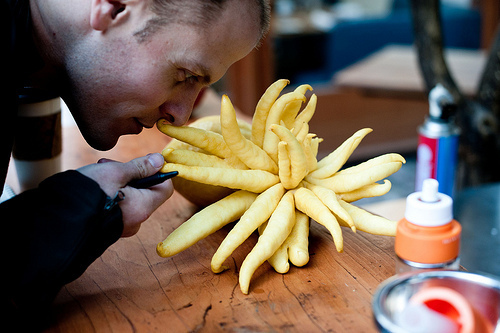
At Saison restaurant in SF, taking in the intoxicating aroma of “Buddha’s Hand” citrus.
During research for The 4-Hour Chef, I ate at well over 100 restaurants in NYC and San Francisco. Below are my favorite Slow-Carb Diet dishes and “cheat day” dishes in both cities, as well as markets and suppliers. Thanks for the help, Trippy!
What will you eat this weekend?
New York City Culinary Maps
The Top Slow-Carb Diet Meals (NYC) map, board
The Top Cheat Meals (NYC) map, board
Top Specialty Markets & Suppliers (NYC) map, board
San Francisco Culinary Maps
The Top Slow-Carb Diet Meals (SF) map, board
The Top “Cheat” Meals (SF) map, board
Top Specialty Markets & Suppliers (SF) map, board
All maps can also be found, color-coded by neighborhood, in the Appendices of The 4-Hour Chef.
For more of my favorites in NYC and San Francisco, please see this piece on Food Republic.
###
ODDS AND ENDS: Errata
- Have you found any errors in The 4-Hour Chef? If so, please let me know here: The 4-Hour Chef Errata Form. Please indicate if you’re using Kindle or the hardcover. Thank so much in advance! My team will jump on fixes ASAP.






Culinary Maps of SF and NYC: The Best Healthy and “Cheat” Dishes (Plus: Party with Me Tomorrow in SF)

At Saison restaurant in SF, taking in the intoxicating aroma of “Buddha’s Hand” citrus.
During research for The 4-Hour Chef, I ate at well over 100 restaurants in NYC and San Francisco. Below are my favorite Slow-Carb Diet dishes and “cheat day” dishes in both cities, as well as markets and suppliers. Thanks for the help, Trippy!
What will you eat this weekend?
New York City Culinary Maps
The Top Slow-Carb Diet Meals (NYC) map, board
The Top Cheat Meals (NYC) map, board
Top Specialty Markets & Suppliers (NYC) map, board
San Francisco Culinary Maps
The Top Slow-Carb Diet Meals (SF) map, board
The Top “Cheat” Meals (SF) map, board
Top Specialty Markets & Suppliers (SF) map, board
All maps can also be found, color-coded by neighborhood, in the Appendices of The 4-Hour Chef.
For more of my favorites in NYC and San Francisco, please see this piece on Food Republic.
###
ODDS AND ENDS: Friday (tomorrow) night hang out, Errata
- Tomorrow, Friday, night, I’ll be holding an “Intimate Evening with Tim Ferriss” at Samovar Tea Lounge in SF. Only about 30 seats are left. It’ll be a small-scale 2.5-hour hangout with me: we’ll drink tea and talk about whatever you’d like. Each person will also receive an original hand-edited page from drafts of The 4-Hour Chef! That’s not available anywhere else. Hope to see you there! Just sign up here.
- Have you found any errors in The 4-Hour Chef? If so, please let me know here: The 4-Hour Chef Errata Form. Please indicate if you’re using Kindle or the hardcover. Thank so much in advance! My team will jump on fixes ASAP.






December 1, 2012
How to Become a Great (Food) Writer: The Big Secret

My first handwritten brainstorm for The 4-Hour Chef, here in a signed copy of The Art of Simple Food by the inimitable Alice Waters.
[Quick preface: Have you left an Amazon review for The 4-Hour Chef, if you've read it? It would mean the world to me if you did! Just takes 20 sec here. I'd love to break 500 reviews. Also, for fun, here is my favorite 1-star review  Now, on to the post...]
Now, on to the post...]
—-
“Don’t be intimidated by the red. You’re all good writers.”
I remember Professor John McPhee saying this when he handed back our first weekly writing assignment. We were 12 or so college seniors in “The Literature of Fact,” his once-in-a-blue-moon seminar at Princeton University. The red was Pulitzer Prize-winning McPhee’s edits and deletions.
Each of us looked down in shock. In some cases, his suggestions exceeded our own black text.
Over the subsequent weeks, our writing tightened. Oddly, as the red shrank, as the flowery adjectives and filler disappeared, my grades in every other class shot skyward.
What I learned: writing is the fastest way to improve your thinking. This carry-over is enough reason to put pen to paper, even if you never intend to publish. Just a week or two of writing for friends can work wonders and produce breakthroughs.
The author of the following article is Jeannette Ferrary. I wanted to include this piece in The 4-Hour Chef but, alas, I had to remove more than 250 pages due to space constraints, including gems like this, a nutritional profile of UFC champion GSP, interviews with the incredible Chef Wylie Dufresne, and more.
But you’re in for a treat.
Jeannette is a food writer for The New York Times who has contributed to everything from Bon Appetit to Gastronomica, reviewing restaurants and penning features. She is the author of eight books related to food, including biographies, memoirs, and cookbooks. She also teaches writing courses at Stanford University. Last but not least, Jeannette studied cooking with Simone Beck and Julia Child in Châteauneuf de Grasse, France.
In other words, she knows both food and writing inside and out. Here are her lessons learned…
Enter Jeanette
I like to begin my food writing courses with a quote about eating an apple that makes everyone’s mouth water. It also often generates a nostalgic tear in the eye because, well, read for yourself:
“I know the look of an apple that is roasting and sizzling on a hearth on a winter’s evening, and I know the comfort that comes of eating it hot, along with some sugar and a drench of cream. I know the delicate art and mystery of so cracking hickory-nuts and walnuts on a flatiron with a hammer that the kernels will be delivered whole, and I know how the nuts, taken in conjunction with winter apples, cider and doughnuts, make old people’s tales and old jokes sound fresh and crisp and enchanting…”
The fun begins as people try to guess the words’ author: a culinary memoirist perhaps, one of those journalist-chefs we read only on Wednesdays; the blogger du jour? Whoever it is, one thing is clear: the person knows how to write. So maybe you love food and your great aunt has left a bunch of yellowing recipe cards that you want to transform into a cookbook spiced with family stories and heritage. Or maybe you’re obsessed with those Hatch chiles from New Mexico and you want to expose their specialness and wonders to the wider world. Or your dream is to become the restaurant reviewer for The New York Times.
You might begin by starting a blog of your own, investigating writing assignments in publications you respect, taking a writing course or a cooking class, getting involved with a culinary organization where you can interact with food-world people on a peer level. But there’s something more basic that you have to do: you have to write what you love. What are you interested in? What fascinates you? It’s a good idea to become obsessed with whatever it is so you can happily lose yourself in your subject and maybe drive everyone around you crazy with your enthusiasm. When you’re writing what you care about, it shows. There’s an energy and vibrancy and sensuousness to your work that you can’t fake. It will sound like you and nobody else, which makes it valuable and unique. I know, I know: you want to know how to become a great food writer. So here’s a little story:
On my first trip to France almost 30 years ago, I went to a restaurant in Cannes called Lyonnaise Provençal which offered a four-course meal for eighteen francs, or about four dollars. Because this was my first real meal in France, I allowed myself the splurge of an extra two-and-a-half francs for a quarter liter of wine. The squid arrived in a boat-shaped dish under a dark tomatoey sauce rich with herbs and with something deeper to say, something more profound than a tomato’s usual discourse. Carrot Provençal was just strips of sweet carrot with orange zest and lots of small but important olives. Salade appeared as a simple bunch of leaves with a surprising message: lettuce can have taste. The cheese course was accurately if too audibly described by an unmistakably American guy a few tables away: “The camembert,” he repeatedly informed his dining partner and everyone else in the room, “is dynamite.”
So why should you care? Because here’s the point of all this: Take notes. These events led directly to the publication of the first article of my food writing career. More recently I used specifics such as these in many chapters of my memoir, Out of the Kitchen: Adventures of a Food Writer. If you want to be a writer whose work is lit up and energized by the telling detail and the palpable freshness of the moment, get yourself a nice, little easy-to-carry notebook. And don’t leave home without it.
Oh, and read as much excellent food writing as you can find, like that in the first paragraph. That would be Mark Twain, by the way. In other words, great food writing is…great writing. Simple as that.
[About the Author: For more on and by Jeannette, please visit her site.]
Books/Resources For Writing
TIM: It’s me again. I have a lot of thoughts on writing, perhaps because I find it so damn hard. Here are a few things I’ve loved and learned since 2005.
Bird by Bird: Some Lessons on Writing and Life - If you spend a lot of time working alone, this book is required reading. It has saved my sanity countless times, and it has done the same for several friends who’ve gone from the deadline hell of “I want to quit” to the New York Times bestseller list.
Out of the Kitchen: Adventures of a Food Writer - This memoir, by the author of this post, traces her journey from youthful ambivalence about food (“women’s work”) to food writer for The New York Times. In the process, a number of legendary cooks and personalities make guest appearances, including Simone Beck, Craig Claiborne, Alice Waters, Judy Rodgers, Julia Child, and Jacques Pepin.
The Stanford d. School “Show Don’t Tell” Design Thinking Bootcamp - How do you create the most powerful story arc, whether written or visual? These fascinating (and free) presentations will kick your creativity into high gear for unique and compelling story structure.
Professor Jennifer Aaker’s “How to Tell a Story” Class - At the very least, try the six-word story exercise. Hemingway made it famous with what he called his best work: “For sale: baby shoes, never worn.” Hat tip to Avi Solomon for pointing me to this.
Writing Online And For Magazines
From First TV to Dr. Oz: How to Get Local and National Media - This post includes the actual query (pitch) I emailed to Wired Magazine that landed a 4-page-plus feature piece.
How to Build a High-Traffic Blog Without Killing Yourself - This article explains how I went from 1 blog reader (Thanks, mom!) to more than 1,000,000 monthly readers by doing the unconventional (e.g., posting once every 3-4 weeks instead of daily). In the accompanying keynote from the annual WordCamp conference, and using my own blog as a case study, I explain best practices, debunk blogging myths, and cover how to harness data for better results. For the record, I suggest first-time bloggers use WordPress.com as a blogging platform. It’s the most Google-friendly (search rankings) out-of-the-box, and I’ve found it easiest to use.
David Lebovitz - Food blogging tips from David Lebovitz, former pastry chef at Chez Panisse and author of six books.
Food Blog Alliance - How-to examples for food bloggers (recipe attribution, shooting food videos, etc.).
Selling Books, Hitting Bestseller Lists
12 Lessons Learned Marketing The 4-Hour Body - This is a step-by-step explanation of everything behind the launch of The 4-Hour Body, which ended up hitting #1 New York Times and outselling The 4-Hour Workweek 5-to-1. If you’re curious about what it takes to keep a book on the bestseller lists for more than four years unbroken, this will give you a rare behind-the-scenes picture. As of this writing, I’m also the only author besides Suzanne Collins (Hunger Games) to have two books in the top-10 of the Kindle “most-highlighted books of all-time.”
Publishers Lunch - The publishing industry’s daily email digest of deals. Learn about books up to a year before they hit the shelves: what sold to which publishers, which agents sold them, and how big the advances were. If you’re hoping to sell a book (non-fiction is best sold before it’s written), this is where to find agents who rep your genre of book, and to discover who is good at creating bidding wars for the big bucks.
Good Food Writing – Exemplars
By no means an exhaustive list, here are a few short stories and books that have inspired me. Each represents a different genre. Consider them a starting point:
Brigade de Cuisine is a New Yorker short story and profile by John McPhee. If you want a taste of why McPhee’s writing makes me cry into a pillow about my own, try this or Coming into the Country.
Heat: An Amateur Cook in a Professional Kitchen is a narrative autobiography by Bill Buford. I quote this book like mad. It’s absolutely hysterical and one of my all-time favorites. The style is reminiscent of George Plimpton, another of my idols.
How to Cook a Wolf is a Depression-era autobiography with interspersed recipes, both by M.F.K. Fisher. Yes, I’ve now recommended this book twice. Go get it.
Like Water for Chocolate (Como Agua Para Chocolate) is award-winning fiction by Laura Esquivel. If you like this and want more foodie fiction, try Mistress of Spices next.
Best Food Writing 2005, 2006, etc. This is an annual anthology of good food writing compiled by Holly Hughes, who pulls from newspapers, books, magazines, blogs, and more. Contributors range from Ruth Reichl and Anthony Bourdain to Jonathan Safran Foer and J. Kenji Lopez-Alt. There’s something for everyone and the pieces are, ahem, bite-sized for easy consumption.






November 30, 2012
The 4-Hour Chef is a NYT, WSJ, and USA Today Bestseller! But There is Mystery and Intrigue…
Thanks to all of you, The 4-Hour Chef will now be featured on all of the big bestseller lists: The New York Times (available to the public shortly), The Wall Street Journal, USA Today, and Publishers Weekly.
THANK YOU!!!
I’m honored to have the opportunity to write for you, and it’s been an amazing trip. It always is. I’ve known some of you since 2007! Seems like a lifetime ago, and I hope to be alongside you for decades to come. Your reviews are what keep me going during the most stressful times.
On that note, let’s look at the week in review: this launch was very different and very challenging. I couldn’t have done it without you, the tremendous online and offline support, including Hastings and the indies backing this book. Without B&N at the party, my team and I had to innovate and experiment to even scratch the lists. Unorthodox bookselling avenues were created (Panera, BitTorrent, etc.) and many new things were learned.
For instance, BitTorrent conversion is NUTS. Of 210,000 downloads (of this bundle) earlier this week, more than 85,000 clicked through “Support the Author” to the book’s Amazon page. We all had to triple and quadruple check that to believe it. Even at a 1% conversion after clicking an effective “buy now” link, that translates to 850 books… and BitTorrent is only accelerating. Wow.
I also came to understand the hard costs of producing The 4-Hour Chef.
This book, a full-color 672-pages at $21-35 end-user pricing, would have been impossible or nearly impossible to produce outside of Amazon Publishing. Marketing and merchandising muscle aside, I owe them tremendous thanks for the most important element of all: paying for exactly what I wanted my readers to have. In the end, product is king. Marketing might get you on the list for a week, but only good content will keep you selling for years. They allowed me to showcase the best of what I had to offer.
To that point: I’m in this for the long-haul, and my goal is never to be a “one-week wonder” on the lists.
I have zero interest in approaching pub date like opening weekend for a big movie. Both of my previous books are still going strong, and my proudest accolade is perhaps the least known. Here it is: there are only two authors (excluding the author/authors of The Bible) who currently have two books in Amazon’s “Most Highlighted Books of All Time” top-10 list: Suzanne Collins of The Hunger Games and me. Crazy but true. Many, many months ago, The 4-Hour Body was #1 for months.
I would love to add The 4-Hour Chef to that top-10 list. That list, which reflects readers’ feeling after buying, is much more important to me than the bestseller lists, which can be gamed. I know exactly how the black-hat folks do it, and I choose not to participate.
Regardless, and much to the chagrin of my critics, I’m just getting warmed up.
This leads us to…
Those bestseller lists — what happened exactly?
For the vast majority of you, the following will be boring. In fact, it’s pretty boring to me, but I need to understand the minutiae. If you’re an author, I’d highly suggest that you get familiar with the lists. They can be fickle and (sometimes) seemingly irrational beasts.
First, here is my previous primer on the basics of the bigger lists.
Next, before we delve into details, a fundamental piece of advice: start-up-style iteration isn’t just for product. It’s also for distribution.
I did NOT pull all my eggs into this first week, precisely because I wanted to iterate distribution. Since I am being boycotted by Barnes & Noble and others, it was unclear which of my sales would be counted or discounted by BookScan and others. I therefore reserved a lot of powder in the keg for later use, once lessons were learned.
It was a good thing I did.
See, I’m as obsessive about book data as I am about tracking physical data. In a single ongoing spreadsheet, I have weekly sales for every channel and every outlet for all of my books since April, 2007.
A few basic observations:
• BookScan only represents 25-30% of the market for most major bestsellers, but its rankings are relatively true, making it a good measure to sort out the variations in the NYT.
• USA Today is the only list that mixes ALL formats, including but not limited to eBooks.
• The NYT Advice list is the only major nonfiction list that doesn’t track eBooks for “Advice, How-to, & Misc.” This means all how-to books and cookbooks are omitted, among others.
• On the main NYT “nonfiction” print list (not “Advice, How-to, Misc.”), O’Reilly was listed as #2 and the #1 book sold half of what he did on BookScan.
• On the ALL formats USA Today list, the #1, #2 and #3 NYT books were at #24, #70 and #35 respectively, all below The 4-Hour Chef‘s #13 ranking.
Pretty odd arithmetic all around, huh? This leads to…
A few observations and questions to the universe:
- Isn’t it odd that 4HC was the #1 non-fiction book sold on Kindle last week, and the #1 ebook on The Wall Street Journal list, but it doesn’t even show up on the NYT ebook bestseller list? Why would that be?
- If the NYT list doesn’t reflect what people are actually reading, what does it reflect? Will they adapt to the times (and full spectrum of non-fiction) or be replaced? I would wager they have a matter of months to decide.
- The NYT does not appear to accept Kindle sales for my book, as it’s from a “single vendor.” That’s really too bad, since Amazon is the largest seller of ebooks in the world. It should be noted that Amazon offered The 4-Hour Chef to Barnes & Noble for their Nook device, and they declined.
- The 4-Hour Chef sold more than 60,000 copies in print and ebook its first week, which would likely put it at #1 on the NYT combined list if its ebook sales were counted. The media is overlooking this print-to-digital mix change and hanging on to the outdated notion that bestseller status = solely print retail sales. I sold more than twice Bill O’Reilly, who had an estimated less than 10k eBooks and was #1 on the NYT eBook list.
- Amazon sold more Kindle copies than print copies of The 4-Hour Chef. My first-adopter demographic is made up of readers who are embracing digital and driving digital growth, so this is not only relevant, but also strategic. We know, for instance, that week-one ebook sales of 4HC were more than week one ebook sales of The 4-Hour Body (over a 30% increase from my last launch, using the 21,000 number on hand), which given my audience–and it could very much be argued the future of book publishing–is a trend in the right direction.
###
None of this is sour grapes.
If I were in this for one week, it might be, but I have big bombs held in reserve, all to be used soon enough. I want The 4-Hour Chef to become a movement, and that will take years to reach full potential, not weeks.
I’m in no rush.
This is a ready, fire, aim-type of game. There is a lot more to come, so keep watching. If B&N would like to join the party, I’ll have a glass of wine waiting. Either way, it’s going to be one hell of a party.
Onward unto the breach!






November 24, 2012
The 4-Hour Chef Launch — Marketing/PR Summary of Week One
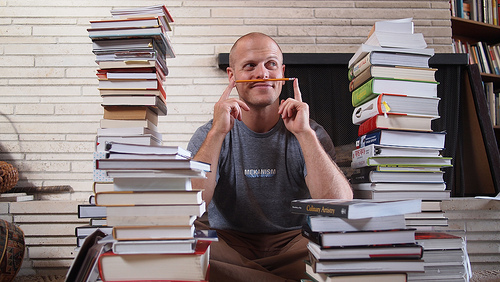
What a whirlwind of a week!
For those of you interested in how I sequence launches, or how punishing the last 7 days have been, or what’s required if you want a shot at #1 New York Times or BookScan, below is a very partial list of media coverage and partnerships. They are in rough chronological order. If I missed anyone, please let me know in the comments!
I’ve done more here than in my last two book launches combined, and reader results (Twitter examples here) have made it all worth it.
I was pleasantly surprised by how many bookstores are now stocking The 4-Hour Chef, which sat at Amazon #2 for most of this week (Diary of a Wimpy Kid is a juggernaut, but Ina Garten is my real competition). According to my readers on Facebook, stocking stores now include Tattered Cover, Copperfields, Powell’s, Elliot Bay, Vroman’s, Prairie Lights, Changing Hands, Boulder Bookstore, and even some Books Inc. (my local fave). Barnes & Noble continues to boycott nationwide, but indies are picking it up, which makes me very happy, of course. It’s exactly where I want a 600+-page full-color book!
Last but not least, sincere thanks to everyone who’s left Amazon reviews!
If you have read the book (or are reading), pretty please take 30 seconds to leave a short review — it would really mean the world to me. Just click here. I have read every review and commented on many of them. At the very least, if you take a look here, there are some great conspiracy theories in the 1-star reviews. Many folks don’t seem to grasp the idea of ADVANCED copies of books, which all authors send out, often in the hundreds. Doing the same doesn’t make me a Scooby-Doo villain or clever mastermind, alas.
Now, to an incomplete list of media from the past 168 hours or so, excluding national advertising…
Offline/traditional names
USA Today – ’4-Hour’ author Timothy Ferriss returns as a chef
The New York Times - Fête Accompli | 4-Hour Feasting
The Wall Street Journal - ’4-Hour’ Man Masters Food, The Good Life
Bon Appetit - A Bird in the Pan: Testing “The 4-Hour Chef”
Outside Magazine – From Modern to Mallman (one of three online, also a print piece)
Wired Magazine – “Better, Faster, Smarter” (Tim Ferriss tests smart drugs) — not yet online but in Dec print.
CBS This Morning (Charlie Rose, Gayle King) – Timothy Ferriss talks food, life lessons
Fox & Friends – ‘Recipe’ for Success
The New York Post – Required Reading
Dr. Oz (almost an hour total on TV, plus online) – Health-boosting Secrets From The 4-Hour Chef Tim Ferriss
Dr. Oz – Tim Ferriss’ Plan to Master Cooking in 4 Hours, Pt 1
Dr. Oz – Tim Ferriss’ Plan to Master Cooking in 4 Hours, Pt 2
Dr. Oz – Tim Ferriss’ Vitamin-Rich Recipes
Partnerships
BitTorrent (160 million+ users — more coming on this)
Panera Bread (1,500+ locations)
TaskRabbit (1,000s of hours saved)
Rally (1,000+ books sold)
Blogs/online press
PaidContent – Ferriss: Even if I sell a million Kindle books, some people will call it a failure
PaleoHacks – If you could become world-class in anything in 2013, what would it be?
BoingBoing – Tim Ferriss’s new book about learning
The Huffington Post – New Timothy Ferriss Book, ’4-Hour Chef’, Has A Great Trailer (VIDEO)
Small Business Trends – Retailers Fight Amazon with Ferriss Boycott
Seeking Alpha – Amazon Is Crushing It
Digital Journal – Review: ‘The 4-Hour Chef’ is more than just a cookbook
TechCrunch – With Amazon Publishing Stonewalled By Retailers, Tim Ferriss Taps BitTorrent To Market His New Book (and more press here)
The Huffington Post – “4-Hour Chef” Tim Ferriss Reveals Secrets of Meta-Learning and Living the Good Life
Ramit Sethi - Live webcast w/ Tim Ferriss this Wednesday, 9PM EST
Danny Roddy – My Interview With Bad Ass Mother Fucker Tim Ferriss
Livestrong – Make Better Meals In Less Time
TubeFilter – With Help Of YouTube, Tim Ferriss Makes Book Trailers Go Viral
Metro – The art of learning
Goins Writer – How to Become World-class at Anything: An Interview with Tim Ferriss
Entrepreneurs-Journey – Tim Ferriss Talks About His Latest Book “The 4-Hour Chef”, How To Learn Anything In Half The Time And Why He Went To Sniper School
99U – Tim Ferriss: On The Creative Process And Getting Your Work Noticed
The Art of Manliness – How to Make the Best Beef Jerky in the World
Cooking for Engineers – Crunchy Bloody Mary
InsideHook – Culinary Design
Man Vs. Debt – Rapidly Learn Any Skill (Including Cooking): An Interview with Tim Ferriss about “The 4-Hour Chef”
Greatist – The 4-Hour Chef: Tim Ferriss’ Crazy, Brilliant Cookbook
Personal Branding Blog – Personal Branding Interview: Tim Ferriss on The 4-Hour Chef
5 Minutes for Mom – An Interview with Tim Ferriss- Author of The 4-Hour Chef
Slashfilm – Author Tim Ferriss Lists His Favorite Cooking TV Shows and Movies
AskMen – Tim Ferriss On The 4-Hour Chef
Chronicles of Strength – How to Learn Anything: Pat Flynn Interviews Tim Ferriss on The 4-Hour Chef
Runkeeper – We’re giving away 20 copies of Tim Ferriss’s new book!
Lifehacker – I’m Tim Ferriss, and This Is How I Work
Shira Lazar: What’s Trending – How to Complete All Your Facebook Tasks in Just 4 Hours: A Tim Ferriss Presentation
Gothamist – After Thanksgiving, Go On A Manhattan Food Marathon
Refinery29 – How To Get Into Every Resto In Town, A Primer By Tim Ferriss
The Grindstone – Tim Ferriss Will Teach You How To Cook In 4 Hours And Conquer The World
Food Babe – The 4-Hour Chef – The Coolest Cookbook I’ve Ever Read
KrisKris – The 4-Hour Chef – Interview With Bestselling Author Tim Ferriss
Wellness Mama – How to Cook Like A Pro and Learn Anything
BoingBoing – Timothy Ferriss: Cheat Sheets for Everything
Cracked – 8 Cheap Ways to Fake Being a Pro Chef
The Huffington Post – The Anti-Hunter’s First Hunt (Exclusive Excerpt)
Gear Patrol – Interview: Tim Ferriss on Steak, Kitchen Tools and the Return of the Polymath
AskMen - The 4-Hour Chef: Exclusive Look: Tim Ferriss’ New Book
Wall Street Cheat Sheet – Tim Ferriss: The 4-Hour Chef Controversy Displays the Future of Publishing
Social Triggers – The simple path to becoming a highly-paid expert (new podcast with Tim Ferriss)
AllFacebook – Humor: How To Complete All Of Your Daily Facebook Tasks In Just Four Hours
Business Insider – The 4-Step Process For Mastering Any Skill
Lifehacker – Use Tim Ferriss’ Four-Step Process to Master New Skills
Cook Taste Eat – Pork Loin with Walnut Purée, Poached Carrots and Bacon Frisée Salad
Podcasts/video/YouTube
Andrew Zimmern: Go Fork Yourself Podcast – Go Fork Yourself: Tim Ferriss & The Four-Hour Chef
creativeLIVE – The 4-Hour™ Life: Healthy, Wealthy and Wise
The Joe Rogan Experience – JRE #285 – Tim Ferriss, Brian Redban
Firepole Marketing - 4-Hour Book Launch Advice from Tim Ferriss
Shira Lazar: What’s Trending – “4-Hour Chef” Tim Ferriss Reveals Secrets Of Meta-Learning And Living The Good Life
Samovar Tea – Samovar Tea Talks with Tim Ferriss
Mixergy – Tim’s Rapid Learning Method And The Four-Hour Chef – with Tim Ferriss
The Art of Charm: Pickup Podcast – Episode #178: Tim Ferriss, FourHourChef.com (FourHourWorkWeek.com)
The New Man Podcast – TNM 125: Tim Ferriss – How to Be Kickass Fast
SiteVisibility – Tim Ferriss – Podcast Episode #189
SourceFed – Greatest Day Ever: a Guide
SimplePickup – How To Make a Sexy Steak with Tim Ferriss
Sources of Insight – Tim Ferriss Interview on The 4-Hour Chef
The Rise to the Top – Tim Ferriss on How to Become World Class in Anything in 6 Months or Less
Radio-TV Interview Report – Steve Harrison Interviews Bestselling Author Tim Ferriss About Book Writing, Promotion and Ways to Learn Any Skill Faster
Alex Day – Unrealistic Goals and Tim Ferriss
New Media Rockstars – Author & Internet Entrepreneur Tim Ferriss Talks to NMR About His New Book The 4-Hour Chef and More! [Interview]
Zen Habits – How to Learn Anything
Big Think – Tim Ferriss: Cooking to Learn Like a Pro (in 4 Hours)
Wall Street Cheat Sheet – Tim Ferris: The 4-Hour Chef Controversy Displays the Future of Publishing
Six Pixels of Separation – SPOS #333 – Learn To Do Anything With Tim Ferriss
Evernote Blog
Yelp! Blog






November 23, 2012
Food Photography Made Easy — Simple Tricks and Pro Tips from The 4-Hour Chef
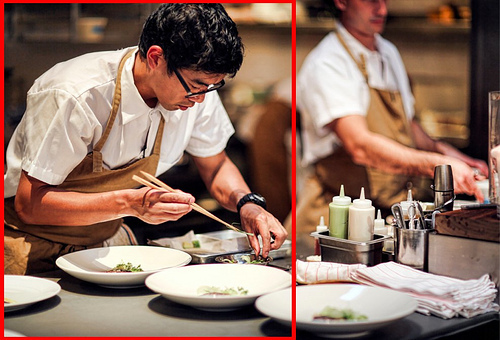
A great pic from Christopher Michel of Central Kitchen in San Francisco. The red box indicates how we cropped for pg. 15 of The 4-Hour Chef.
Christopher Michel has taken pictures from outer space. OK, technically, it was aboard a U-2 “Dragon Lady” spy plane at the edge of space. But still.
Best known as founder of Affinity Labs, Chris has one of the most unbelievable bios I’ve ever seen. Between serving on the board of the U.S. Naval Institute and acting as an Entrepreneur-in-Residence at Harvard Business School, he’s managed to publish four fine art books full of his photographs. He’s the one responsible for getting me interested in photography. After taking my pic with his favorite M9 and Leica Noctilux (50mm, f/.95 lens), and after seeing me marvel at the quality, he insisted I get a proper camera to chronicle my adventures and misadventures.
But what camera to get? And what about lenses and all the other accessories? “50mm” meant nothing to me, nor did “f/.95.” The jargon is enough to make your head spin.
Based on my scattered research, it seemed that I needed an expensive Frankenstein’s monster of high-grade gear. Thankfully, before I could max out my AMEX, Chris suggested a smaller and less expensive combination: the Olympus PEN E-PL2 micro four thirds camera (body) and Panasonic Lumix G 20mm f/1.7 Aspherical Pancake Lens. It was this precise suggestion that took me from my long-standing “I should really get into photography” to actual shooting.
The gear was no longer my bottleneck.
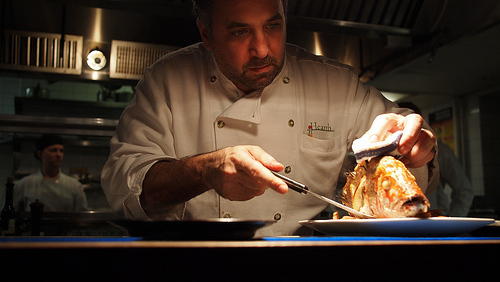
Chef Marco Canora serving up red snapper at the wonderful Hearth in NYC. We drank almost five bottles of wine that night.
And this combo! It turned out perfect for close-up food photography, even in very low-light conditions. It was simplicity itself to turn A below (iPhone) into B (exact same shot with Olympus/Lumix):
A – Parmesan and white chocolate macaron at Saison, complete with gold leaf. Taken with the iPhone.
B – Same shot… but much more beautiful. Taken with an Olympus PEN E-PL2 and Panasonic Lumix pancake lens.
Roughly 20% of the 1,000+ photos in The 4-Hour Chef were taken by me using the aforementioned gear. No Photoshop, no zoom, nothing fancy; just a nice lens and improved composition thanks to Understanding Exposure by Bryan Peterson, which is required reading.
That’s more than enough to get started and kick ass. The above is all I used for six months.
But there’s more fun to be had, naturally. Let’s look at the iPhone and the big guns, each in turn, as you can blend the best of both worlds…
There’s An App For That
What if you don’t want to lug a “real” camera to every meal? Np, as the youngsters say. The pros get sick of feeling like pack mules, too.
The following iPhone recommendations are from Darya Pino, a Neuroscience PhD and well-known food blogger at SummerTomato, one of Time’s 50 Best Blogs of 2011. Her posts feature photos taken with both professional gear (including full lighting set-up and tripod) and her iPhone. Some of the latter are jaw-droppingly stunning, which was always puzzling, as I couldn’t replicate any of it.
No longer. When Darya leaves the backpack at home, here are the apps she uses to level the playing field:
“This is, by far, my fave. It’s simple to use and all the functions work amazingly well. For quick editing, I use ‘tune image’ for the kind of adjustments you’d make in Photoshop: levels, brightness, contrast, saturation, white balance, tilt shift, etc. I like to up the saturation a bit to brighten the greens, etc., especially in low light. Tilt shift is similar to depth of field, making the focal point more focused and the rest blurrier.
This is the minimum I do for most photos I post online. If you need a little more functionality, Photogenie is also a great editor.”
Snapseed Only
Snapseed With Tilt Shift – Fish On Sticks
“This is essential for taking the photos before you edit them. It really helps for food photography. The biggest issue with food is that it is wet. Plus, it’s often served in low lighting. In restaurants, this makes dishes look brown and disgusting, especially if you compound the problem with flash.
You won’t need it every time, but in weird lighting or situations where you want a lot of detail, it can’t be beat. It also has some basic editing capability, but I usually move to Snapseed instead. Camera+ also takes nice pics and has some interesting filters, but it has too many functions for my taste and feels heavy. Kevin [Kevin Rose, her fiancee and renowned tech influencer] likes it a lot, though.”
ProHDR Only
ProHDR + Snapseed: After ProHDR, Darya used Snapseed to up the “ambiance,” improve the white balance and saturation, straighten the image, add a tilt shift effect, and crop it slightly.
“This is also worth purchasing, in my opinion. It only has one function, but it does it really well. Basically, it lets you turn a photo black and white, then selectively return the color to anywhere in the photo by rubbing your fingertip on it. It creates an awesome effect when used well.”
ColorSplash, With Fruit
“I use Instagram as a social app, rather than for editing. I use the above apps to shoot and edit, then I share the images via Instagram. One awesome thing about this app is that the web links (these appear when you Tweet your pic) take people to nice big, high-res pics that work for almost any blog.”
Photo from Instagram
The Pro’s
But what it you want to take it up a notch? That’s when I pose questions to award-winning photographer Penny de los Santos, who’s shot for Saveur, National Geographic, Sports Illustrated, and Time, among others.
Are there any real rules for shooting food?
People have all these rules about shooting food. Here are a few I’ve heard repeated by young photographers during workshops I’ve led:
• Avoid photographing food on purple surfaces or purple linens.
• When photographing spaghetti, tuck in all the ends of the noodles.
• Always use a tripod.
Throw those out the window. Whatever it is people say you shouldn’t do, ignore it. I shoot a ton without a tripod and I always laugh when people say it’s the most important thing.
The big secret is to buy the best ingredients you can. Go to the farmer’s market, not the grocery store, the morning of the shoot. Don’t buy one bunch of beets, buy 3 or 4. Buy the produce that looks the best. It’s not about how it tastes.
If you’re shooting meat or vegetables that have been cooked, it’s always nice to brush them up with a little bit of olive oil before you shoot it to make it come alive and give it some shine.
What are some of the biggest mistakes that novices make?
The first mistake a lot of amateurs make is they shoot with their camera’s built-in flash.
The second is they stay in one position, where the food lands right before they eat it. It’s important to look at food from every angle, not only adjusting your proximity to the plate, but also adjusting the food so that you see it the best.
The third is that most people shoot food way too close. They want to see the drips coming off the meat. Instead, pull back and give your subject some space.
Is there any equipment you can’t live without?
You don’t need to have a deep camera bag. You can do it with just one lens.
Once you have an iPhone 4s or better, you can choose depending on your budget:
Bodies:
Canon G15 (about $500) or Lumix GF3 ($279). These are both great small cameras that shoot RAW, have HD video, and are excellent for food.
Canon 5D Mark III ($3500 body) or Canon 5D Mark II ($2500 body): Top of the line, professional-quality gear. The latter is the former’s still-great predecessor.
Lenses:
I use Canon’s 24–105mm f/4L a lot (about $1,000)
Props:
Props are essential for bringing your photographs to life. Go to thrift stores and garage sales and find old vintage plates and weathered boards and start a prop closet. Collect forks and knives and bowls that have a lot of character, and then use those as a vessel for your food. If you can’t spend the time searching, Etsy.com and eBay are great for propping. If you have a budget and live in a big city, you can rent from prop houses. Or go check out a prop house to scout what they have, then set out to get your own.
If someone wants to teach themselves how to be a great food photographer, how do they start?
It’s important to learn the basics of photography first. Then, don’t miss opportunities to train your eye. Look at the food magazines—I like Donna Hay and Saveur. Study photographers, not just self-described “food photographers.” I’ve been inspired by four masters in seeing, finding moments, and harnessing beautiful light: Sebastian Salgado, Henri Cartier-Bresson, Irving Penn, and Martin Parr. The last two see the potential in food and have a strong voice about it.
Take a food photography workshop to understand what it means to shoot food and how to approach food. Then challenge yourself. Give yourself five recipes one day, make the dishes, and really think about how you’re going to photograph each one.
###
Everybody has to eat, so why not shoot what you’re eating?
Be playful. Food photography isn’t just one glamour shot before your stuff your face. Take a few shots before you eat, a few more once it’s half eaten, and capture the mess at the end with the wadded up napkin. Perhaps that tells a better story?
And stories are what create better memories for you… and evoke stronger emotions from viewers. Have fun with it.
###
Related food pics and coverage — The 4-Hour Chef launch dinner:
- The New York Times – Fête Accompli | 4-Hour Feasting
- The Wall Street Journal – ’4-Hour’ Man Masters Food, The Good Life






November 21, 2012
What to Do If Boycotted by 1,000+ Bookstores? Open Your Own Bookstores, Of Course.
So far, The 4-Hour Chef has had some great allies, including Panera (complete with new hidden Slow-Carb Diet menu), BitTorrent (bundle here), and Hastings. In San Francisco, Samovar Tea Lounges in now selling signed copies in all locations!
But I’m most excited about my next partner: you.
What to do if 1,000+ books stores are boycotting you? Create your own bookstores, of course. That’s where The Army of Davids Campaign comes in.
- From now until Friday at midnight PST, interested readers can sell The 4-Hour Chef through their own “bookstore” Fan Fundraising pages on Rally.org here.
- I will donate $6 of every book sold (100% of my royalties and then some) to DonorsChoose.org to help high-need public school classrooms.
THE PRIZES
#1 – Grand Prize for most books sold (500 books minimum): An all-expenses-paid overseas food sabbatical with me and friends. You’ve seen me host trips to India, Africa, and elsewhere. They’re always a blast. Though details are TBD and dates will be mutually agreed, it’s likely we’ll be doing a high-end trip through Tuscany, Italy.
#2 and #3 – Runners-up Prize for second and third most books sold (250 books minimum): An all-expenses-paid full-day trip to SF to see my favorite spots and enjoy mastermind jam sessions with me and a small group of entrepreneurs.
Find full details here, and I hope to travel with you soon! If you need an inspirational video to get you pumped, here’s one of my favorites. Avante!








